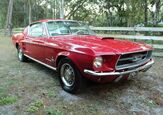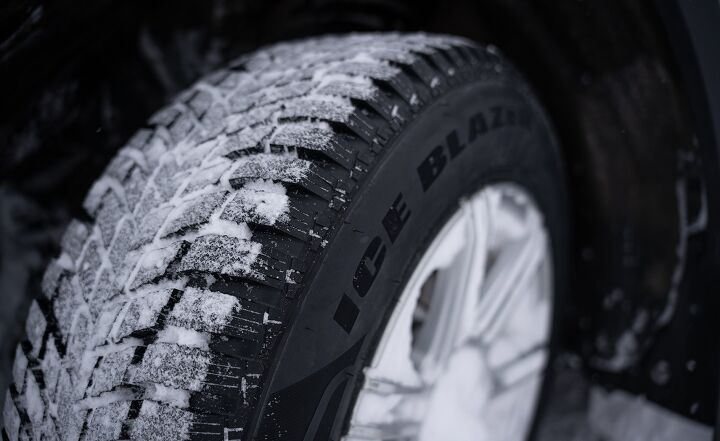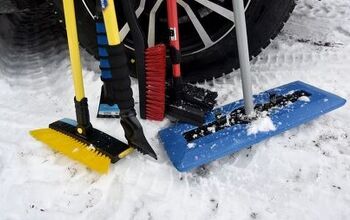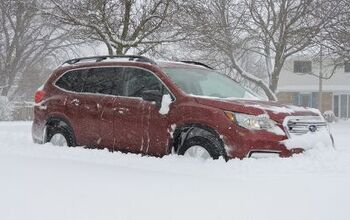Sailun Ice Blazer WSTX Winter Tire: Long-Term Review

Earlier this year Sailun launched the latest evolution of the brand’s Ice Blazer line of tires. As it’s the first new winter tire from the manufacturer in quite some time, the new Sailun Ice Blazer WSTX is a big deal. It’s also the perfect opportunity for us at AutoGuide to perform another in-depth, winter-long tire test.
This year our test vehicle is a 2023 Subaru Crosstrek. Powered by the upgraded 2.5-liter engine, we have downsized our winter tires to a set of 225/60R17 Sailun Ice Blazer WSTX tires on 17-inch steel wheels. For those unfamiliar with this new tire, all the details can be found here, but we’ll provide a quick recap.
Like other tires in the Ice Blazer lineup, the WSTX is a studdable winter tire. There are over 60 sizes to choose from for wheels 14 to 20-inches in diameter. It incorporates a silica-reinforced compound formula with polymer blends. In simpler terms, it’s a design that should keep the tire flexible, yet stable, in a variety of temperature settings.
As winter tire tread pattern is of the upmost importance, Sailun utilizes staggered V-shape tread blocks. The goal here is good snowy weather performance and stability. The lateral grooves on the tire are designed to expel water and slush away from the surface rubber.
When things are colder and icier, the 3D siping comes into play. These squiggly lines found all over the tire’s tread blocks are meant to grip icy surfaces when accelerating, cornering, and braking.
Table of contents
First Update – Warm, Dry, and Rainy
So far, none of the new tire’s design sounds much different than previous Ice Blazer models. Ah, but there is the key word—sound. During our long-term test of the Sailun Ice Blazer WST2 LT last winter, we appreciated everything about the tire other than the amount of road noise and vibration it created.
Road noise is always an unwanted by-product of winter tires, no matter the brand. With more aggressive tread patterns, hundreds of sipes, and sharper edges, there’s always going to be that unwanted road rumble. Some winter tires are better at suppressing these sounds than others, though. The Sailun Ice Blazer WSTX aims to be one of those tires. Basically, the goal is to be everything we like about the WST2 LT, but in a quieter package.
After a few weeks of driving, we can confirm Sailun has succeeded on the noise front. In dry and wet road conditions, the Ice Blazer WSTX is much closer to pricier tires in terms of road noise. Are they as quiet as the most premium tire lines from top tier manufacturers? No, as there is still some pronounced hum and vibration. But the new Ice Blazers are more on par with moderately priced tire lines from tier 1 tire manufacturers. More importantly, they are noticeably quieter than the previous Ice Blazer winter tires we tested, yet still hold a price advantage over much of the competition.
On warm fall days, when temperatures rose into the upper 50s F (mid-teens C), the tires behaved similarly to the all-season rubber they replaced. No excessive squirm, or squishiness. The tires operated as intended, much like replacement all-season tires do.
First Update: First Taste of Snow
Unexpectedly, one mid-December morning, we awoke to our first snow covering of the season. It wasn’t a snowstorm or a significant snowfall, but a slushy mess that granted us the first bit of slippery conditions in which to test the tires.
In light slush, acceleration occurs with minimal slip, cornering grip is better than expected, and braking is adequate. It doesn’t take more than a few minutes behind the wheel to gain confidence in the tire’s behaviour in these conditions. The grip levels are very linear, and there’s no surprise when approaching the edge of the tire’s traction limit. It’s a very predictable driving experience.
Continue to check back all winter long as we continue to update this post with more impressions.
[gallery columns="2" size="large" ids="974766,974770"]
Second Update – Finding Winter
Winter has been surprisingly mild up to this point. The usual cold snaps, snowstorms, and freezing rain that plagues our region have been surprisingly absent. But fear not, we are determined to give you, the reader, a proper account of how the Sailun Ice Blazer WSTX handles all winter conditions. So, if winter won’t come to us, we’ll go to where it’s wintery.
The destination – the iCar racing circuit north of Montreal, Quebec. Notorious for its long, cruel winters, the region did not disappoint as temperatures hovered around 5 degrees Fahrenheit (-15 Celsius) with the wind chill during our testing. Compounding to the conditions is the 10 inches of fresh snow (25 cm) that fell the night before.
Instead of bringing my Subaru Crosstrek along for the ride, a more controlled test was set up for us. We’re driving the new Ice Blazer WSTX back-to-back with Firestone Winterforce tires. The test subjects are a pair of identical vehicles; two front-wheel drive Toyota Corollas and two all-wheel drive Toyota RAV4s.
Second Update – Front-Wheel Drive Results
Our first test involves the Corollas. One car has a set of Sailuns installed while the other has a set of the Winterforce tires installed. We put the cars through a series of maneuvers that includes accelerating, cornering, braking, and emergency lane change maneuvers.
When it comes to accelerating, the Ice Blazers provide a bit more initial grip and get the car underway quicker and with less drama. When it comes to handling, the Winterforce provides more initial bite which allows the car to rotate faster. In fact, the front tires dig in so quick with the Firestone tires, it’s possible to get the rear end to start to over rotate during slalom-like maneuvers.
The Sailuns feature less initial grip, but do provide ample cornering ability, in a far more predictable, not-so-tail-happy experience. It’s the tire that the majority of consumers will feel more comfortable with while those looking for maximum performance may prefer the Winterforce.
When it comes to braking, there is no noticeable difference between the two tires.
Second Update – All-Wheel Drive Results
We switch over to the all-wheel drive RAV4 for our second test. After a few runs, we find there is no noticeable difference in acceleration or braking between the two tires. This isn’t much of a big surprise considering the low speeds we are testing at and the all-wheel drive system that masks some of the tire’s performance.
When it comes to cornering though, things flip compared to our impression with the Corolla. There is more noticeable initial bite from the Sailun tires now compared to the Firestones. Both tires will lose all grip around the same speed, but the Sailuns offer more cornering grip initially.
Second Update – Test Results
My biggest take away from testing is that different tires behave differently on different cars. Testing tires in these extreme conditions may seem a bit, well, extreme. But it’s a good indication of how the tires will perform on unpredictable wintery roads.
As has been the case for its predecessors, the new Sailun Ice Blazer WSTX continues to offer comparable performance in heavy, wintery conditions compared to pricier tires.
Sailun Ice Blazer WSTX

A 20+ year industry veteran, Mike rejoins the AutoGuide team as the Managing Editor. He started his career at a young age working at dealerships, car rentals, and used car advertisers. He then found his true passion, automotive writing. After contributing to multiple websites for several years, he spent the next six years working at the head office of an automotive OEM, before returning back to the field he loves. He is a member of the Automobile Journalists Association of Canada (AJAC), and Midwest Automotive Media Association (MAMA). He's the recipient of a feature writing of the year award and multiple video of the year awards.
More by Mike Schlee











































Comments
Join the conversation
I'm not sure where you are seeing Blizzaks for $115. In my tire size these Sailun Ice Blazers WSTX are $145 each vs the Blizzak's at $296 each, quite a significant price difference. Any January updates before I pull the trigger on a set? Thanks
Hi Alex, No updates since this report. Winter disappeared form our parts for the past month or so. Hoping for some messy weather soon to write an update. There will be a serious test of these tires in late January. -Mike